1956 Topps # 59 Jose Santiago [WB] (Indians)
![1956 Topps # 59 Jose Santiago [WB] (Indians) cards value](/jpgs/no-image.jpg)

Please wander around the website for more info, prices, values & images
on vintage baseball, football, basketball, hockey, sport and non-sports cards.
1970/1972/1973 Topps Candy Lids |

1956 Topps Football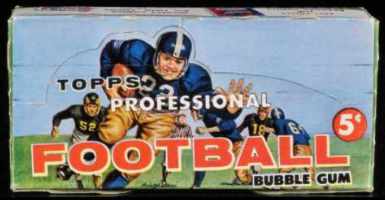 After they acquired Bowman, Topps issued its first NFL licensed
football set issuing (120) brightly colored cards.
Team cards were a nice new addition to the earlier Bowman offerings.
Also issued was a checklist and (5) special contest cards.
Most of these special cards were either tossed away or sent in
to win prizes making them quite difficult to find.
After they acquired Bowman, Topps issued its first NFL licensed
football set issuing (120) brightly colored cards.
Team cards were a nice new addition to the earlier Bowman offerings.
Also issued was a checklist and (5) special contest cards.
Most of these special cards were either tossed away or sent in
to win prizes making them quite difficult to find.
Like its early 1950's baseball issues, these cards measured in at 2-5/8" x 3-3/4", sligtly larger than the regular modern issued cards.
Each team had (9) player cards and the team card.
To make the number of cards work with the card-sheet size,
Topps printed all the cards twice on each sheet, EXCEPT the
Washington Redskins and Chicago Cardinals who were short
printed (single printed)and are more difficult to find.
Note: You may be on that page right now. |


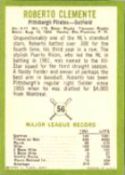
1963 Fleer Baseball Cards
|

Cabinet Card Were oversized trading cards featuring paintings issued mostly 1910-1915.
Card Show is a gathering of dealers & collectors looking to buy/sell/trade sports cards and memorabilia.
Card Stock is the material a card is printed on. Usually paper-based, today companies play with the card stock and sometimes it appears to be wood or leather or see-thru acrylic ...
Cello Pack is a card pack whose wrapper is see-thru plastic. Usually the top & bottom cards are seen. Unopened cello packs showing major stars and rookies sell for heavy premiums.
Centering is the balance of the borders: top/bottom & left/right. On perfectly-centered cards, top/bottom borders match as do the left/right borders. Centering is presented as a set of numbers & directions and often included with the grade. Perfectly-centered is "50/50 t/b" AND "50/50 l/r". As centering gets worse, one number increases and the other decreases. For example: 90/10 t/b is considered extremely off-center top to bottom. The numbers add up to 100 (50/50, 60/40, 90/10 ...).
Certificate Of Authenticity (COA) A document used to verify legitimacy of a collectible. NOTE: Keep in mind that COA's are easier to fake then autographs.
Common A card of a non-star player is considered a "Common" as opposed to cards of a star players or specialty/subset cards such as league leaders, teams cards, World Series cards...
Condition (Grade) Centering, corner wear, photo clarity, edges, creases, print flaws ... all combine to determine a card's condition or grade. Along with rarity/scarcity it is the major factor in a card's value.
Crease Defect usually caused by bending the card. Hard to see, or not, a crease lowers the card's grade (VG or lower) and greatly diminishes it's value.

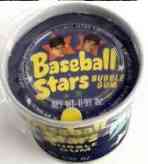 Topps has tried many crazy products, called "test issues".
Mostly distributed in limited areas, test issues were scarce.
"Candy Lids" were little tubs of candy with player's photos on
bottom of a 1-7/8" lid. 10 cents/tub, 24 tubs/box.
Topps has tried many crazy products, called "test issues".
Mostly distributed in limited areas, test issues were scarce.
"Candy Lids" were little tubs of candy with player's photos on
bottom of a 1-7/8" lid. 10 cents/tub, 24 tubs/box. 

 1970 Topps Candy Lids were called "Baseball Stars Bubble Gum",
had 24 players, the 1973 Topps Candy Lids had 55.
1970 Topps Candy Lids were called "Baseball Stars Bubble Gum",
had 24 players, the 1973 Topps Candy Lids had 55.  Topps 1973 Pinups & Comics share many of the same photos.
Topps 1973 Pinups & Comics share many of the same photos. 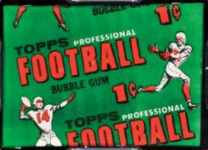
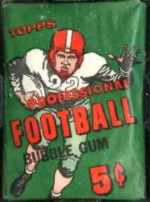 Top Rookies: Lenny Moore, Roosevelt Brown, Joe Schmidt, Bill George...
Top Rookies: Lenny Moore, Roosevelt Brown, Joe Schmidt, Bill George...
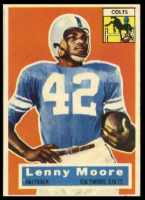
 1963 Fleer baseball card set was cut short at 66 cards & checklist
by Topps lawsuit. But what 66 cards! Attractive & packed:
Clemente,Koufax... & 2 very scare Short Prints.
1963 Fleer baseball card set was cut short at 66 cards & checklist
by Topps lawsuit. But what 66 cards! Attractive & packed:
Clemente,Koufax... & 2 very scare Short Prints.  Maury Wills 'rookie' card is a story.
Majors in 1959, quickly superstar. But 1963 for rookie ???
In 1959 Topps deemed Wills NOT WORTHY.
Maury Wills 'rookie' card is a story.
Majors in 1959, quickly superstar. But 1963 for rookie ???
In 1959 Topps deemed Wills NOT WORTHY. 
 Wills was upset. After 1962 MVP, Topps came knocking but he said "NO!".
Finally, 1967, Wills first Topps & most costly card.
Note: 1961 Post Cereal card, years BEFORE
Wills was upset. After 1962 MVP, Topps came knocking but he said "NO!".
Finally, 1967, Wills first Topps & most costly card.
Note: 1961 Post Cereal card, years BEFORE
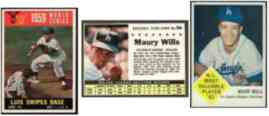 'official' rookie. He also photo-bombed a 1960 Topps card.
'official' rookie. He also photo-bombed a 1960 Topps card. 